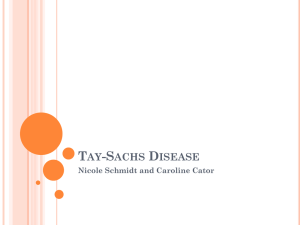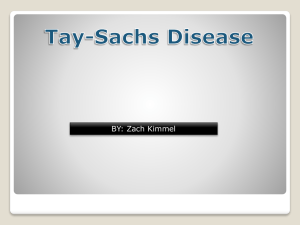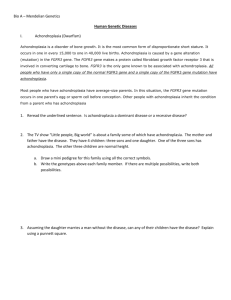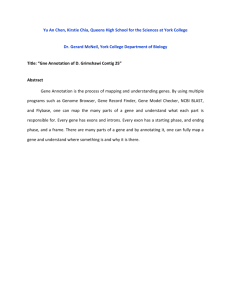you are a genetic counselor
advertisement
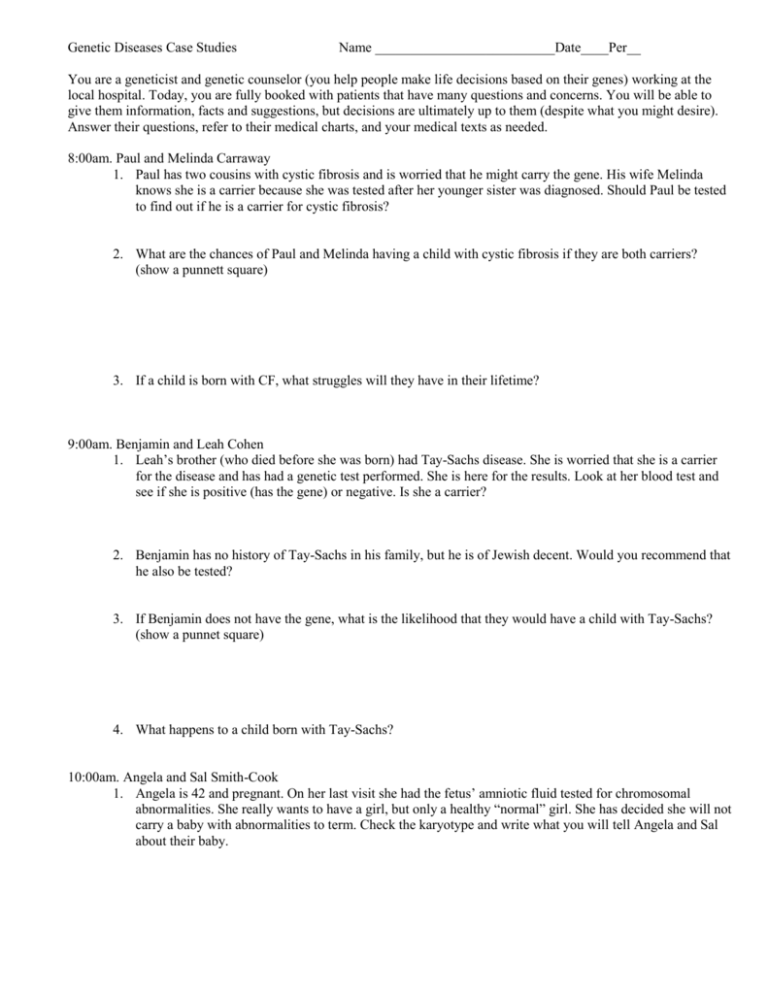
Genetic Diseases Case Studies Name __________________________Date____Per__ You are a geneticist and genetic counselor (you help people make life decisions based on their genes) working at the local hospital. Today, you are fully booked with patients that have many questions and concerns. You will be able to give them information, facts and suggestions, but decisions are ultimately up to them (despite what you might desire). Answer their questions, refer to their medical charts, and your medical texts as needed. 8:00am. Paul and Melinda Carraway 1. Paul has two cousins with cystic fibrosis and is worried that he might carry the gene. His wife Melinda knows she is a carrier because she was tested after her younger sister was diagnosed. Should Paul be tested to find out if he is a carrier for cystic fibrosis? 2. What are the chances of Paul and Melinda having a child with cystic fibrosis if they are both carriers? (show a punnett square) 3. If a child is born with CF, what struggles will they have in their lifetime? 9:00am. Benjamin and Leah Cohen 1. Leah’s brother (who died before she was born) had Tay-Sachs disease. She is worried that she is a carrier for the disease and has had a genetic test performed. She is here for the results. Look at her blood test and see if she is positive (has the gene) or negative. Is she a carrier? 2. Benjamin has no history of Tay-Sachs in his family, but he is of Jewish decent. Would you recommend that he also be tested? 3. If Benjamin does not have the gene, what is the likelihood that they would have a child with Tay-Sachs? (show a punnet square) 4. What happens to a child born with Tay-Sachs? 10:00am. Angela and Sal Smith-Cook 1. Angela is 42 and pregnant. On her last visit she had the fetus’ amniotic fluid tested for chromosomal abnormalities. She really wants to have a girl, but only a healthy “normal” girl. She has decided she will not carry a baby with abnormalities to term. Check the karyotype and write what you will tell Angela and Sal about their baby. 11:00am. John Remmin 1. John’s father was diagnosed with Huntington’s disease at 32 years old – only 2 years after John was born. Now that John is married and thinking about having children of his own, he is concerned that he might also have Huntington’s disease. His test results are in, what will you tell John? 2. If John decides to have children, what are the chances that they will have Huntington’s disease? (show punnett square) 3. What symptoms can John expect to experience in a few years? 1:00pm. Keenan and Demetria Davis. 1. Keenan and Demetria both grew up in the United States but their parents immigrated from South Africa. They want to start a family, but both of them had one parent with Sickle Cell Anemia. They have both been healthy their whole lives and have been tested to see if they carry the gene. Look at their blood work and tell them their results. 2. What are the chances that they will have a child with sickle cell anemia? (Show punnet square) 3. What are the chances that they will have a child who carries the gene? 4. What are the chances that they will have a child who does not have the gene at all? 2:00pm. Amy and Matt Rolof. 1. Amy and Matt Rolof are both little people with Achondroplasia. They want to know if they have any chances of having children with normal height, children who are little and also, if they could have stillborn children. Use a punnett square to explain their chances for all three phenotypes. 3:00pm. Sandra and Matt Ellington. 1. Sandra is 25 and has hypochondriac tendencies. She constantly worries that she has many different diseases and that she will pass them all to her children. She is especially afraid that she will get breast cancer. Her mother, grandmother and older sister have all had breast cancer. She has been tested for the gene (BRCA1,2) and you are ready to give her the results. Choose your words carefully, and write them below. 2. What preventative measures could she take? 3. Is she likely to pass this on to her children? How do you know? Medical Records Medical Record for: Cohen, Leah Sex: F 234 Main St. Washington Date Medical Test Sept. 4 Blood Test Low hexosaminidase A activity Likely carries Tay-Sachs gene Medical Record for: Smith-Cook, Angela Sex: F 654 Aloha St. Washington Date Medical Test Sept. 2 Amniocentesis, fetus is 12 weeks CONFIDENTIAL MATERIAL Medical Test CONFIDENTIAL MATERIAL Medical Test Medical Record for: Remmin, John Sex: M 789 Wallow Way. Washington Date Medical Test Sept. 3 Blood Test 109 CAG repeats Medical Record for: Davis, Keenan Sex: M 567 E. 1st Ave Washington Date Medical Test Sept. 4 Blood Test Low amounts of Hemoglobin S (HbSS) Medical Record for: Davis, Demetria Sex: F 567 E. 1st Ave Washington Date Medical Test Sept. 4 Blood Test Low amounts of Hemoglobin S (HbSS) Medical Record for: Ellington, Sandra Sex: F 574 Blossom St. Washington Date Medical Test Sept. 4 Base pair analysis of BRCA1 45 mutations CONFIDENTIAL MATERIAL Medical Test CONFIDENTIAL MATERIAL Medical Test CONFIDENTIAL MATERIAL Medical Test CONFIDENTIAL MATERIAL Medical Test Base pair analysis of BRCA2 20 mutations Medical Texts Tay Sachs Healthy babies develop vision, movement, hearing, and other vital functions in part because enzymes clear out fatty protein and other unwanted material that can interfere with growth. But a baby with Tay-Sachs disease is born without one of those important enzymes, Hexosaminidase A (Hex A). So, as those fatty proteins build up in the brain, they hurt the baby's sight, hearing, movement, and mental development. Children with the disease usually die before the age of five. A child can only get Tay-Sachs by inheriting it. The genetic trait is relatively common among certain ethnic groups, such as Ashkenazi Jews. Tay-Sachs can be detected before birth, so couples in at-risk ethnic groups who are thinking of having children may want to get a blood test to find out whether their child would be likely to have it. Who Is at Risk for Tay-Sachs? Each year, about 16 cases of Tay-Sachs are diagnosed in the United States. Although Ashkenazi Jews (Jews of central and eastern European descent) are at the highest risk, it is now also prevalent in non-Jewish populations, including people of French-Canadian/Cajun heritage. Some people carry the genetic mutation that causes Tay-Sachs, but do not develop the full-blown disease. Among Ashkenazi Jews, 1 in 27 people are carriers; in the general population, 1 in 250 people are. A child can only have Tay-Sachs disease if both parents are carriers of the gene. Tay-Sachs is a recessive trait. Achondroplasia dwarfism occurs as a sporadic mutation in approximately 85% of cases (associated with advanced paternal age) or may be inherited in an autosomal dominant genetic disorder that is a common cause of dwarfism. A person with achondroplasia is heterozygous and has only one mutated gene (the other is normal). If both parents of a child have achondroplasia, and both parents pass on the mutant gene, then it is very unlikely that the homozygous child will live past a few months of its life (often the child is stillborn). It is possible for two parents with achondroplasia to pass on normal genes and have children of average adult heights. The disorder itself is caused by a change in the DNA for fibroblast growth factor receptor 3 which causes an abnormality of cartilage formation. Achondroplastic dwarfs have short stature, with an average adult height of 131 cm (4 feet, 3½ inches) for males and 123 cm (4 feet, ½ inch) for females. The prevalence is approximately 1 in 25,000. Down Syndrome Trisomy of the 21 chromosome.
